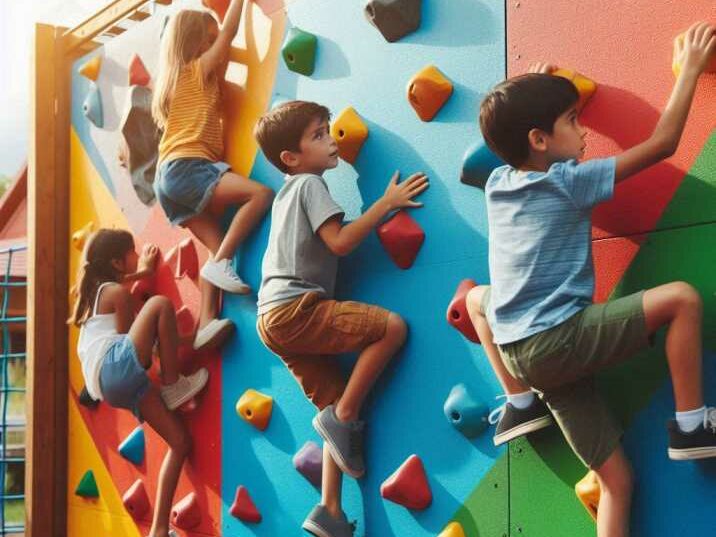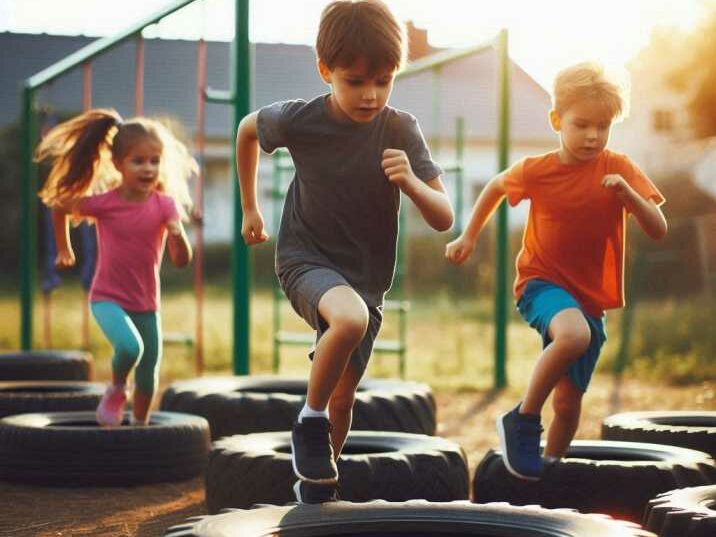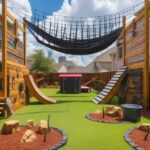Introduction:
Table of Contents
Welcome to the world of outdoor obstacle courses for kids, where fun and adventure meet physical and mental challenges. Engaging in an obstacle course not only provides hours of entertainment but also offers numerous benefits for children’s overall development. In this article, we’ll explore the exciting world of outdoor obstacle courses, offering creative ideas, safety guidelines, and valuable insights to help you create an unforgettable experience for your kids.

Table of Contents:
- The Importance of Outdoor Play
- Getting Started: Planning Your Outdoor Obstacle Course
- Essential Obstacles for an Outdoor Obstacle Course
- Safety First: Guidelines for a Secure Obstacle Course
- Benefits of Outdoor Obstacle Courses for Kids
- Safety Guidelines for Obstacle Course Construction:
- Incorporating Educational Elements:
- Customization for Special Needs:
- Community Involvement and Events:
- Environmental Impact and Sustainability:
- Conclusion
The Importance of Outdoor Play:
Outdoor play is crucial for children’s overall development. It provides numerous benefits that contribute to their physical, cognitive, and emotional well-being. Here are some key reasons why outdoor play is important for kids:
- Physical Health: Outdoor play encourages physical activity, helping children develop strong muscles, improve coordination, and enhance overall fitness. It reduces the risk of obesity and promotes a healthy lifestyle.
- Cognitive Development: Engaging in outdoor activities stimulates children’s imagination, creativity, and problem-solving skills. It allows them to explore and interact with their environment, fostering curiosity and cognitive growth.
- Emotional Well-being: Being outdoors exposes children to natural elements like sunlight and fresh air, which have a positive impact on their mood and mental well-being. It also provides opportunities for social interactions and building friendships, boosting their self-esteem and social skills.
- Sensory Stimulation: Outdoor play engages all five senses, offering a rich sensory experience. Children can feel different textures, hear various sounds, see vibrant colors, smell fragrant flowers, and even taste fresh produce from nature. This sensory stimulation enhances their sensory processing abilities and cognitive development.
Getting Started: Planning Your Outdoor Obstacle Course
Choosing the Perfect Location:
When selecting the location for your outdoor obstacle course, consider the following factors:
- Space: Ensure that the area provides enough space to accommodate the obstacles and allows children to move around freely. A spacious backyard or a nearby park can be ideal options.
- Safety: Choose a location that is free from hazards such as sharp objects, steep slopes, or dangerous terrain. It should be easily accessible and away from busy roads or other potential risks.
- Natural Elements: Look for a location that incorporates natural elements like trees, rocks, or hills. These elements can add excitement and authenticity to the obstacle course.
Determining the Course Layout:
Designing an effective course layout is essential to maximize the fun and challenge for children. Consider the following tips:
- Start and Finish: Determine where the course will begin and end. This helps create a clear path for children to follow and adds structure to their experience.
- Obstacle Placement: Strategically place obstacles throughout the course, ensuring a logical flow and progression of difficulty. Begin with easier obstacles and gradually increase the challenge level.
- Variety: Include a variety of obstacles that target different skills and abilities, such as balance, strength, coordination, and problem-solving. This ensures an engaging and well-rounded experience for children.
Selecting Age-Appropriate Obstacles:
When choosing obstacles for your outdoor course, it’s important to consider the age and abilities of the children participating. Here are some examples of age-appropriate obstacles:
- Younger Children (ages 3-6): Balance beams, stepping stones, low hurdles, and tunnels are suitable obstacles for younger children. These obstacles focus on improving balance, coordination, and gross motor skills.
- Middle Children (ages 7-10): Monkey bars, rope climbs, cargo nets, tire runs, and crawling tunnels can challenge children in this age group. These obstacles enhance upper body strength, agility, and problem-solving abilities.
- Older Children (ages 11+): Incorporate more advanced obstacles like wall climbs, rope swings, zip lines, and higher-level balance beams. These obstacles require higher levels of strength, endurance, and coordination.
Essential Obstacles for an Outdoor Obstacle Course:
- Tire Run: The tire run is a classic obstacle that requires children to jump from tire to tire, testing their agility and coordination. It helps improve balance, spatial awareness, and lower body strength.

- Balance Beam: The balance beam challenges children to walk across a narrow beam without falling off. This obstacle enhances balance, core stability, and concentration. It also helps develop fine motor skills and body control.
- Rope Climb: The rope climb obstacle requires children to ascend a vertical rope using their upper body strength. It improves grip strength, upper body muscle development, and overall endurance. It also fosters confidence and perseverance.
- Monkey Bars: Monkey bars are a staple in outdoor obstacle courses. They require children to swing from bar to bar using their upper body strength. This obstacle enhances grip strength, upper body coordination, and spatial awareness. It also promotes problem-solving skills and builds confidence.
- Tunnel Crawl: The tunnel crawl obstacle involves crawling through a tunnel or crawling space. It enhances gross motor skills, coordination, and spatial awareness. It also encourages creativity and imaginative play.
- Cargo Net: The cargo net obstacle challenges children to climb up and over a net. It improves upper body strength, coordination, and problem-solving abilities. It also fosters teamwork and builds confidence in overcoming obstacles.
Safety First: Guidelines for a Secure Obstacle Course:
- Protective Gear: Ensure children wear appropriate protective gear, such as helmets, knee pads, and elbow pads, to minimize the risk of injury during the obstacle course.
- Supervision and Monitoring: Always have adult supervision present to ensure children are using the obstacle course safely. Keep an eye on their progress, provide guidance when needed, and address any safety concerns promptly.
- Regular Course Inspections: Conduct regular inspections of the obstacle course to identify any potential hazards or wear and tear. Repair or replace damaged equipment promptly to maintain a safe environment for the children.
Benefits of Outdoor Obstacle Courses for Kids:
- Physical Development: Outdoor obstacle courses promote physical fitness, strength, and endurance. They improve gross motor skills, coordination, and balance. Regular participation in obstacle courses can contribute to a healthier lifestyle and reduce the risk of childhood obesity.
- Cognitive Skills: Obstacle courses require problem-solving, strategic thinking, and decision-making. Children learn to analyze challenges, plan their movements, and adapt their strategies. This enhances their cognitive abilities, critical thinking, and spatial awareness.
- Emotional Well-being: Engaging in outdoor obstacle courses boosts children’s self-confidence and self-esteem as they conquer challenges and improve their skills. It also provides an outlet for stress and pent-up energy, promoting emotional well-being and a positive mindset.
- Social Interaction: Outdoor obstacle courses encourage teamwork, cooperation, and communication among children. They learn to collaborate, support each other, and develop social skills through shared experiences. This fosters friendships, empathy, and a sense of belonging.
Safety Guidelines for Obstacle Course Construction:
- Ground Preparation: Ensure the ground is level and free from any sharp objects or debris to prevent tripping hazards.
- Obstacle Stability: Securely anchor all obstacles to the ground to prevent tipping or movement during use.
- Clear Pathways: Maintain clear pathways between obstacles to allow easy movement and prevent congestion.
- Weather Considerations: Consider weather conditions when planning the obstacle course. Ensure that it is safe to use during different weather scenarios and provide shade or shelter if necessary.
Incorporating Educational Elements:
- Learning Stations: Integrate educational elements into the obstacle course, such as stations where children can solve puzzles, answer riddles, or learn about nature.
- Environmental Awareness: Use the obstacle course as an opportunity to teach children about the environment, wildlife, and conservation through interactive displays or themed obstacles.
Customization for Special Needs:
- Inclusivity: Ensure that the obstacle course is accessible and inclusive for children with diverse abilities. Consider incorporating sensory-friendly elements and providing alternative routes for children with mobility challenges.
- Sensory Integration: Create sensory-rich experiences within the obstacle course to accommodate children with sensory processing differences, such as tactile elements and auditory stimuli.
Community Involvement and Events:
- Family Engagement: Organize family-friendly events or community gatherings centered around the obstacle course to promote social interaction and physical activity.
- Fundraising Opportunities: Use the obstacle course as a platform for fundraising events or charity drives to support local causes and initiatives.
Environmental Impact and Sustainability:
- Eco-Friendly Materials: Consider using sustainable and eco-friendly materials for constructing the obstacle course to minimize environmental impact.
- Nature Integration: Design the obstacle course to complement the natural surroundings, incorporating elements that blend harmoniously with the environment.
Conclusion:
Outdoor obstacle courses offer a thrilling and rewarding experience for children. By incorporating essential obstacles like tire runs, balance beams, rope climbs, monkey bars, tunnel crawls, and cargo nets, children can develop physical abilities, problem-solving skills, and confidence. However, safety should always be a priority, with the use of protective gear, adult supervision, and regular inspections. The benefits of outdoor obstacle courses extend beyond physical development, encompassing cognitive growth, emotional well-being, and social interaction. So, get ready to create an unforgettable adventure for your kids and watch them thrive in the exciting world of outdoor obstacle courses.
FAQs:
What age range is suitable for an outdoor obstacle course?
An outdoor obstacle course can be tailored to suit children of all ages. However, it’s essential to choose age-appropriate obstacles and ensure proper supervision for younger children.
How can I make the obstacle course challenging yet safe?
To strike the right balance, choose obstacles that are challenging but not too difficult for your child’s age and physical abilities. Implement safety measures such as protective gear and regular inspections to ensure a secure experience.
Are outdoor obstacle courses only for physically active kids?
Outdoor obstacle courses are suitable for all children, regardless of their physical abilities. The courses can be adapted to challenge and engage kids at various fitness levels.
Can I create an obstacle course in a small backyard?
Absolutely! Even a small backyard can be transformed into an exciting obstacle course. You can utilize compact obstacles and design creative layouts to maximize the space available.
How can an obstacle course benefit my child’s development?
Outdoor obstacle courses promote physical fitness, cognitive skills, emotional well-being, and social interaction. They provide a holistic approach to development and help children build essential life skills.


